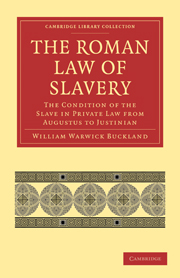Book contents
- Frontmatter
- PREFACE
- Contents
- ERRATA, ADDENDA, AND LIST OF ABBREVIATIONS
- LIST OF PRINCIPAL ABBREVIATIONS
- PART I CONDITION OF THE SLAVE
- PART II ENSLAVEMENT AND RELEASE FROM SLAVERY
- APPENDIX I The relation of the contractual actions adiectitiae qualitatis to the Theory of Representation
- APPENDIX II Formulation and Litis Consumptio in the actions adiectitiae qualitatis
- APPENDIX III Form used by Slave in acquisition by Mancipatio, etc.
- APPENDIX IV The essential character of Manumission: Iteratio
- APPENDIX V Manumission vindicta by a, filiusfamilias
- INDEX
APPENDIX IV - The essential character of Manumission: Iteratio
Published online by Cambridge University Press: 07 September 2010
- Frontmatter
- PREFACE
- Contents
- ERRATA, ADDENDA, AND LIST OF ABBREVIATIONS
- LIST OF PRINCIPAL ABBREVIATIONS
- PART I CONDITION OF THE SLAVE
- PART II ENSLAVEMENT AND RELEASE FROM SLAVERY
- APPENDIX I The relation of the contractual actions adiectitiae qualitatis to the Theory of Representation
- APPENDIX II Formulation and Litis Consumptio in the actions adiectitiae qualitatis
- APPENDIX III Form used by Slave in acquisition by Mancipatio, etc.
- APPENDIX IV The essential character of Manumission: Iteratio
- APPENDIX V Manumission vindicta by a, filiusfamilias
- INDEX
Summary
To analyse the conception of manumission so as to express it in terms of other institutions is perhaps impossible. It has an obvious affinity with conveyance, and Vangerow, treating it as essentially an act of transfer, deduces from this character its main rules, so far as they are concerned with latinity. But though this affinity is clear, it is no more than an analogy, and it is not alone. What was given to the man was not dominium over himself: no man has that. The lex Aquilia gave no action to a man for personal damage, precisely for this reason. It is true that Vangerow holds this text of no force in this connexion; he says that what Ulpian means is that the lex applies only to ownership of things in the ordinary sense, and this does not cover his ownership of himself. But what Ulpian says is that the man has no actio Aquilia, because he is not dominus of his members. That is, his right is not dominium. That it is analogous to ownership is true, but this does not justify Vangerow's inferences. Personal independence is not ownership of one's person. We know that manumission by will is not a legacy. What is conferred is liberty with citizenship. If the analogy with transfer of ownership were identity, or had been the most prominent factor in the minds of the lawyers, we might have expected a development of mancipation with safeguards; we should have looked for discussion of the question whether one freed informally or under 30 (thinking he was older), would acquire libertas ex iure Quiritium by one year's usucapion.
- Type
- Chapter
- Information
- The Roman Law of SlaveryThe Condition of the Slave in Private Law from Augustus to Justinian, pp. 714 - 717Publisher: Cambridge University PressPrint publication year: 2010First published in: 1908



